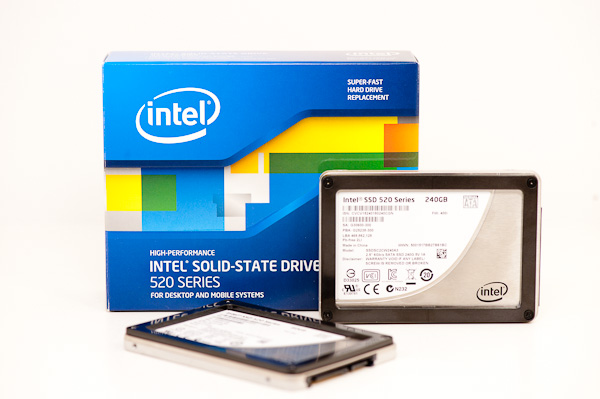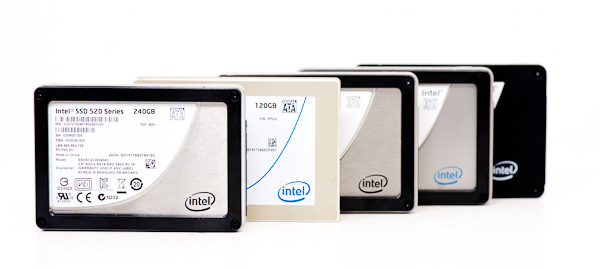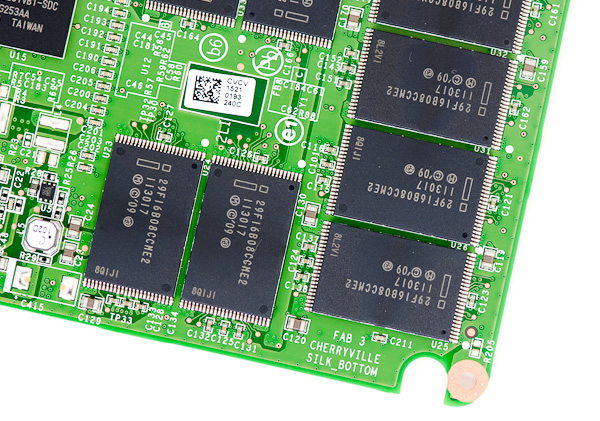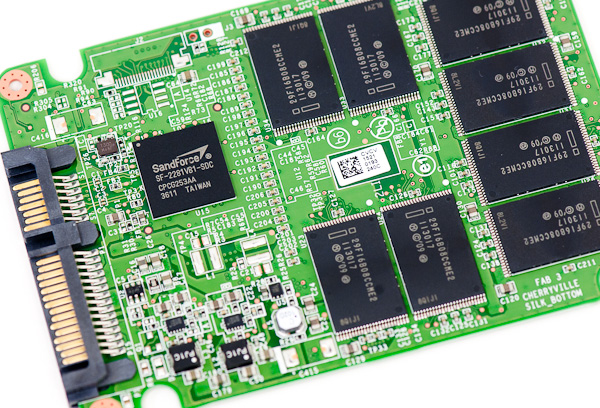Intel SSD 520 Review: Cherryville Brings Reliability to SandForce
by Anand Lal Shimpi on February 6, 2012 11:00 AM ESTIntel was rumored to be working on a SandForce based drive for several months now, but even the rumors couldn't encapsulate just how long Intel and SF has worked on this drive. According to Intel, the relationship began 1.5 years ago. Still lacking a 6Gbps controller of their own and wanting to remain competitive with the rest of the market, Intel approached SandForce about building a drive based on the (at the time) unreleased SF-2281 controller. Roughly six months later, initial testing and validation began on the drive. That's right, around the time that OCZ was previewing the first Vertex 3 Pro, Intel was just beginning its extensive validation process.
Codenamed Cherryville, Intel's SSD 520 would go through a full year of validation before Intel would sign off on the drive for release. In fact, it was some unresolved issues that cropped up during Intel's validation that pushed Cherryville back from the late 2011 release to today.
Intel's strenuous validation will eventually make SandForce's drives better for everyone, but for now the Cherryville firmware remains exclusive. Intel wouldn't go on record with details of its arrangement with SandForce, but from what I've managed to piece together the Intel Cherryville firmware is exclusive for a limited period of time. That exclusivity agreement likely expires sometime after the SF-2281 is replaced by a 3rd generation controller. There are some loopholes that allow SandForce to port bug fixes to general partner firmware but the specific terms aren't public information. The important takeaway is anything fixed in Intel's firmware isn't necessarily going to be fixed in other SF-2281 based drives in the near term. This is an important distinction because although Cherryville performs very similarly to other SF-2281 drives, it should be more reliable.
As Intel has been working on this firmware for quite a while, it's likely that the 520 uses an older branch of the SF-2281 firmware that has been updated over the past twelve months.
The BSOD is Back, but Not on Intel
Back in October SandForce announced that it had discovered a firmware issue that resulted in unexpected BSODs on SF-2281 drives on certain platforms. Why it took SandForce several months to discover the bug that its customers had been reporting for a while is a separate issue entirely. SandForce quickly pushed out the firmware to OCZ and other partners. Our own internal testing revealed that the updated firmware seemed to have cured the infamous BSOD.
Just as background, our SSD testing is rarely over once the review goes live. Any drive we recommend gets tossed into a primary use machine somewhere within the company. We keep track of drive behavior, including any bugs or performance issues over time. This long term testing process takes place over months. The results of these long term tests are folded into future reviews and recommendations.
The BSOD is caused by a bug in SandForce's power state logic that ultimately results in the drive disconnecting from the system while it's running. It turns out that Windows isn't a fan of you hot un-plugging the drive it's running on, which results in the BSOD. We had two systems that exhibited the BSOD, both of which were fixed by the update last October.

As luck would have it, our own Brian Klug happened to come across an unexpected crash with his 240GB non-Intel SF-2281 based SSD two weeks ago when he migrated it to another machine. The crash was an F4 BSOD, similar in nature to the infamous BSOD issue from last year. While two of the systems we reproduced the BSOD bug on were cured by last year's firmware update, Brian's system (an X58/Core i7 build) was BSODing regularly playing Battlefield 3. Games end up being a great way to trigger the SF-2281 BSOD issue as they frequently switch between periods of idle and load, which does a good job of stressing the power state logic in SandForce's firmware. I immediately sent Brian an Intel SSD 520 to see if the BSOD remained on Intel's drive. Switching to Cherryville caused Brian's BSODs to go away. Indeed most end user reports of SF-2281 BSODs went away with the fixed firmware, but we've still heard of isolated issues that remain unresolved. Whatever Intel has done with the 520's firmware seems to have fixed problems that still remain in the general SF-2281 firmware.
This is actually a dangerous precedent as it means one of two things. The first possibility is that SandForce has been made aware of flaws in its current firmware and chooses against (or is legally prevented from) disclosing it to its partners. The second possibility, and arguably even worse for SandForce, is that Intel was able to identify and fix a bug in the SF-2281 firmware without SandForce knowing it existed or was addressed. I suspect it's the former but as no one is willing to go on the record about the Intel/SandForce agreement I can't be certain.
Intel did go on record saying that the 520 is expected to have far fewer F4/F7 BSODs than any other SF-2281 drive. I asked Intel if I should read into the phrase "far fewer", but the answer was no - the 520 is expected to have similar reliability to the Intel SSD 510 and 320.
At the end of the day that's what Intel really brings to the table with the 520. As you'll soon see, performance isn't very different compared to other SF-2281 based drives. Intel's biggest advantage comes from the unique firmware that ships with the drive. Intel is also quick to point out that while other SF-2281 manufacturers can purchase the same Intel 25nm MLC NAND used on the 520, only Intel's drives get the absolute highest quality bins and only Intel knows how best to manage/interact with the NAND on a firmware level. While it's nearly impossible to prove most of this, the fact that we're still able to reproduce a BSOD on the latest publicly available SF-2281 firmware but not on the SF-2281 based Intel SSD 520 does say a lot about what you're paying for with this drive.
And you are paying a premium for the 520 compared to other SF-2281 based SSDs on the market today:
| Intel SSD 520 Price Comparison | |||||||
| 60GB | 120GB | 180GB | 240GB | 480GB | |||
| Intel SSD 520 (SF-2281) | $149 | $229 | $369 | $509 | $999 | ||
| Kingston HyperX (SF-2281) | N/A | $205 | N/A | $420 | N/A | ||
| OCZ Vertex 3 (SF-2281) | $95 | $190 | $240 | $375 | $850 | ||
| Samsung SSD 830 | $110 | $220 | N/A | $360 | $800 | ||
Last year Intel hinted at a move from the consumer market to enterprise server and client markets. The 520's higher price likely won't matter there, but for consumers the higher price is noticeable - particularly with good options from companies like Samsung now available on the market.














138 Comments
View All Comments
GrizzledYoungMan - Monday, February 6, 2012 - link
Excellent review, Anand. I really appreciate your focus on reliability/compatibility over performance in your latest SSD reviews; that really reflects my own experience in terms of where SSDs need to improve.Do you (or anyone) know when the Intel 520 is scheduled to be available for sale? I didn't notice this information in your article.
Here's hoping it's soon. I am returning a newly purchased Crucial m4 (which has a number of rather absurd semi-known/unacknowledged issues, like stuttering with Intel RST drivers installed, and failing to wake up from sleep) and seeking to replace it with an Intel drive. After owning OCZ and Crucial, I am really looking forward to not having to extensively modify my system just to get things working.
GrizzledYoungMan - Monday, February 6, 2012 - link
This just came up on Amazon: http://www.amazon.com/Intel-SSDSC2CW120A3K5-2-5-In...Price looks right, and is sold by Amazon directly. Can anyone confirm that this model number is correct?
ckryan - Monday, February 6, 2012 - link
Cherryville has been selling in small quantities for weeks now. Benches and pics have been out there. I thoroughly enjoy every one of Anand's SSD reviews as it's never just a review of the drive, but in this case the 520's performance profile has been established well in advance of NDA expiration.Intel's reliability is well deserved IMHO. For those of us wishing against hope for Intel's 10 channel 6gbps controller, keep hoping. As late as 60 days ago, I was hoping that the 520 would utilize the Marvell controller, but when Cherryville started shipping a few weeks back, all hope was lost. And it was pretty obvious when the specs were leaked months and months ago.
Intel's own controller is not fast by the standards of today, but Intel really got to the heart of the matter with the first and second gen drives, which is speed is superfluous without reliability.
SandForce drives have been tamed to a large extent with the 3.3.2FW, but I'm unconvinced of their long term reliability -- the nDurance chart literature reproduced in the article is not realistic in any way, and in my experience SF drives tend to lose in endurance compared to it's competitors. I still own and use SF drives, but when I need reliability over speed, SF is not the way I personally choose to go.
I respect Intel's decision to go SF, and in it's entirely likely that no drive has received the internal scrutiny that the 520 has -- and I'm sure it will pay dividends. But I won't be selling my older Intel drives on eBay anytime soon.
GrizzledYoungMan - Monday, February 6, 2012 - link
Good comment, and useful thoughts, thank you.Since you seem to have a lot of experience with these devices, and similar priorities as me, which would you pick for the system disk of a workstation: the 320 or the 520, both at 120GB? I'm on a p55 mobo with a 3gb/s SATA controller, FYI.
While the performance of the 520 series is attractive, I'm still inclined to believe that I wouldn't notice the real world difference between the two. In which case the 320 series wins on demonstrated reliability.
ckryan - Monday, February 6, 2012 - link
The 320 has a great record -- it's one reliability fault was the rare 8MB error, since corrected. Firmware is so crucial with SSDs, and the actual act of updating FW can cause issues of it's own (ala the Samsung 830, another excellent drive).On a 3gbps Intel mobo port you won't get the sequential speeds, but you will get the good random performance and the 520 handily bests it's fore-bearers in that area.
So I suppose that the issue of price should be considered. The 120GB 320 and 520 are going to be nearly the same price -- so you'd be getting more with the 520. I would say if you're comfortable with it, get the 520.
Regardless of whether SSD or HDD, you should be in a position that if the drive dies 20 minutes from now, restoring your data to it shouldn't be a problem. With that in mind, you can probably bet that the 520 will hold out for it's 5 year warranty. If it doesn't, you still have a 5 year warranty.
As an aside, I recently bought a 320 series 120GB just to have on hand should the need arise, and it is pretty magnificent. I think most people would be just as happy with a 320 than a faster 520 -- the people who crave speed are going to get the fastest drive anyway, so for everybody else the 320 series is still a viable option.
Roland00Address - Monday, February 6, 2012 - link
The 80gb intel 320 has routinely been on sale for the last month from several different online retailers. The sales involve mail in rebates but you see final MIR prices being between 70 to 90 dollars for the 80gb.The 120gb intel 320 on the other hand hasn't really gone on sale in Janurary, only time it went on sale in the last few months was a black friday sale (and BF is not a normal thing.)
GrizzledYoungMan - Tuesday, February 7, 2012 - link
Just bought a 120gb Intel 320 series SSD for $182.00 - nearly $1.50 a gig. Not bad.Between the reliability (both in terms of software, architecture, and power loss protection) and the insane IO performance on reads at lower queue depths, I feel confident I made the right choice.
alpha754293 - Monday, February 6, 2012 - link
Reading this, I'm tempted to buy the 180 GB version because I will be using it in a HPC environment.And if the OCZ Vertex 3 is going to have BSOD issues, I'd rather pay a little bit of a premium or lose a little in storage capacity in order to make sure that the system will be humming along perfectly/nicely.
Such a shame/waste that the Vertex 3s are relegated to being just data drives.
neotiger - Monday, February 6, 2012 - link
It doesn't look like Intel 520 has any capacitors to prevent data loss.So how is this SSD any different from the 5,000 other SandForce SSD's already in the market, except this one is much more expensive than the others?
Sunrise089 - Monday, February 6, 2012 - link
Read the article ;)